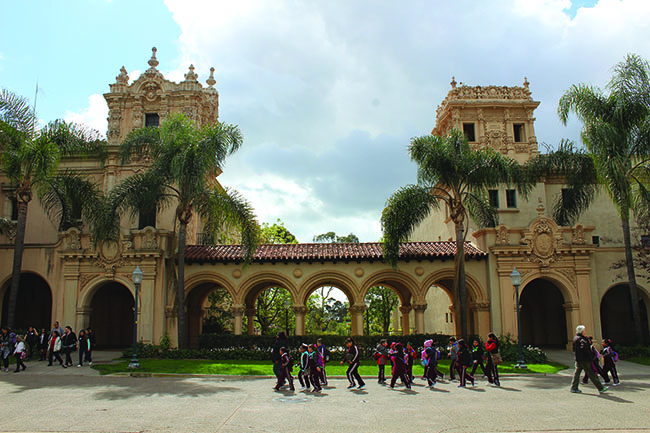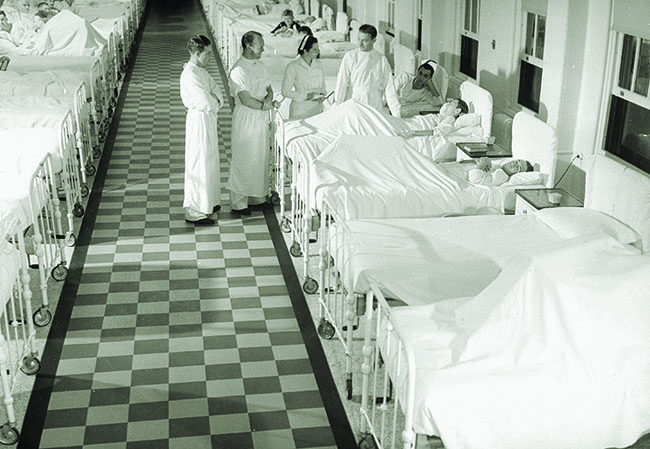ON A CRISP FEBRUARY MORNING, I stroll along El Prado, the palm- and portico-lined pedestrian pathway that gives San Diego’s Balboa Park its classic Old-World charm. Most of my fellow camera-slung tourists are here for the first-class museums housed inside Spanish Colonial buildings, whose ornately carved yellow-orange facades perfectly complement the bold, blue sky. I, however, have come not for artifacts and artwork, but to catch glimpses of the park’s little-known wartime tenure as the world’s largest naval infirmary. Through the course of World War II, some 172,000 of the most seriously wounded sailors, Marines, and (occasionally) soldiers were shipped from all theaters to these sunny climes for treatment at Naval Hospital San Diego, which specialized in rehabilitating injured veterans for return to civilian life.

San Diego’s deep ports and high coastal bluffs have enticed military development since 1769, when Spain established the first garrison here. In 1868, two decades after the United States acquired California in the Mexican-American War, leaders of the expanding municipality created the 1,400-acre City Park on a few scrub-covered mesas a mile northeast of downtown. As San Diego prepared to host the 1915–16 Panama–California Exposition as a tribute to the Central American republic’s new canal, the park was renamed for the first European to view the Pacific Ocean, 16th-century Spanish conquistador Vasco Núñez de Balboa. Designers laid the bricks of El Prado and surrounded them with exotic flora and Renaissance-style exhibit houses that would become museums and civic offices at the expo’s close.
My search for Balboa Park’s war ties begins southeast of El Prado, where field-tripping schoolkids are working out their wiggles on the shiny jungle gyms of Pepper Grove playground. The city encouraged the navy to establish a tent dispensary on this spot 102 years ago for wounded doughboys. The first permanent Naval Hospital San Diego, dubbed the “Pink Palace” for the hue of its stucco exterior, opened across the street at Inspiration Point in 1922.
By the time war returned in 1941, San Diego had become a major defense hub and the hospital complex boasted 56 buildings and 1,424 beds. On December 10, the city lent 33 acres a half mile west, in the park’s Palisades area, for Camp Kidd Naval Training Station, named for Admiral Isaac C. Kidd, who had died at Pearl Harbor three days earlier. Here, inside art deco structures built for a second expo in 1935–36, the navy opened a Hospital Corps School and an aircraft repair program that trained medical officers and mechanics in the latest measures for saving men and planes. These facilities still celebrate innovation today as the San Diego Automotive and Air & Space Museums.
From the Palisades, I head northeast among acacias and queen palms to the cavernous buildings lining El Prado, just as the men of the Hospital Corps did when, in early 1943, the swelling number of sick and wounded servicemen overwhelmed the facilities at Inspiration Point. On March 5, the Museum of Man, Natural History Museum, and Fine Arts Gallery were the first of El Prado’s treasured institutions to be drafted into service as military hospital wards, each with orders to pack away its exhibits and relocate offices to make way for a particular medical specialty. Sailors and Marines helped curators prepare more than one million artifacts for storage, occasionally stopping to admire such finds as the Museum of Man’s collection of ancient Japanese weaponry.
During a late morning squall, I take refuge in the former Fine Arts Gallery, now the San Diego Museum of Art, one of few park buildings that have not been replaced in the seven decades since the war.
After gladly swapping the entrance fee for shelter from the pounding rain, I join the parade of squeaky-shoed visitors admiring the large museum’s diverse collection, from a crumbling quartzite statue of Egypt’s Ramesses II to a haunting 1939 oil portrait by Mexican painter Diego Rivera. During the bare-wall days of the war, treasures like these were dispersed among storage, other art museums, and the mansion of a well-to-do local family who hosted a makeshift public gallery. Meanwhile, orderlies darted among the museum’s broad archways and finely etched railings, doting on patients as they recovered from heart and lung surgeries.
Of course, as wartime medical wards went, Balboa Park wasn’t bad. “If you have to be ill, I can think of no place more conductive to recovery than this beautiful hospital,” First Lady Eleanor Roosevelt remarked during a surprise visit in July 1944.

The finest perk was San Diego’s fair weather, which returns in time for my eastward stroll down El Prado. Next to the Museum of Art stands the Botanical Building, whose sprawling lath rotunda provides the iconic backdrop for the park’s signature water feature, the 8,000-square-foot Lily Pond. In 1943, resourceful navy engineers cleared the pond of its namesake plants and increased its three-foot depth to an average of five feet, creating a swimming pool used for patient rehabilitation and—when the summer heat became too much—recreation. Today, mallard ducks have replaced lounging sailors, much to the amusement of penny-tossing toddlers.
At the east end of El Prado, I wrench open the doors of the three-story Natural History Museum, another original building, which served as an infectious disease ward during the war. Sunlight streaming in through the glass ceiling and tall windows illuminates the atrium’s colossal prehistoric residents—an allosaur, a megalodon, and a sea cow. Now I understand why the navy’s eviction notice had posed particular challenges for this locally beloved museum known as “the Nat.”
A chime to my right heralds the arrival of an elevator come to ferry weary stroller-pushing parents to the top-floor exhibits. They step in, likely without a clue that the lift was installed by the navy to transport patients suffering from contagious respiratory and skin diseases. The lift also serviced a small museum research office in the basement that remained open during the war. In October 1943, its curators delightedly received a parcel from local naturalist Josiah E. Green containing 32 reptile and bug specimens he collected while deployed as a Marine captain on Guadalcanal.
As the war progressed and Naval Hospital San Diego developed advanced plastic surgery, orthopedics, and neurosurgery programs, the patient census ballooned, peaking at 12,000 in December 1944. In time, dozens of additional Balboa Park buildings were requisitioned for use as hospital wards, nurse dormitories, the standard military base amenities, and a few peculiar to Balboa’s cultured past. Exiting the Nat, I follow the unmistakable bombastic tones of one to their origin.
I arrive at Spreckels Pavilion just in time to join a few dozen visitors applauding a performance on the world’s largest outdoor organ. Its 5,000 gold-hued pipes have been entertaining San Diegans since the first day of the 1915 expo. Throughout the war, Navy Reserve specialist First Class D. Robert Smith, a gifted music professor in peacetime, gave weekly recitals to soothe shell-shocked servicemen.
By mid-1945, Naval Hospital San Diego’s 241 buildings and 10,499 beds made it the largest military hospital in the world. At war’s end, the navy began the slow retreat back to Inspiration Point. Here, I end my day as well, with a peek inside the Balboa Park Veterans Museum, housed in an interdenominational chapel that opened in January 1945. Like Balboa Park’s war story, the chapel is easy to miss amid the shadows of the modern Naval Medical Center San Diego, which replaced the original complex in 1988. But this quiet sanctuary, adorned with stained glass and thoughtfully arranged tokens of a century of American war-fighting, pays perfect homage to the men who found healing here for their tattered bodies and troubled souls. ✯





